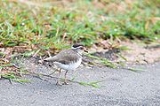
Three-banded Plover
Encyclopedia
The Three-banded Plover or Three-banded Sandplover, Charadrius tricollaris, is a small wader
. This plover
is resident in much of eastern and southern Africa
and Madagascar
, mainly on inland rivers, pools and lakes. Its nest is a bare scrape on shingle.
The adult Three-banded Plover is 18 cm in length. It has long wings and a long tail, and therefore looks different from most other small plovers in flight, the exception being the closely related Forbes's Plover
which replaces it in west Africa.
The adult Three-banded Plover has medium brown upperparts, and the underparts are white except for the two black breast bands, separated by a white band, which give this species its common and scientific names. The head is strikingly patterned, with a black crown, white supercilia
extending from the white forehead to meet on the back of the neck, and a grey face becoming brown on the neck. The eye ring and the base of the otherwise black bill are red.
The Madagascan subspecies C. t. bifrontatus has a grey band between the bill and the white forehead, and the sides of the head are grey. The sexes are similar, and the juveniles of the nominate and Madagascan subspecies also resemble the adults, although the forehead is brownish for a short time.
This species is distinguished from the larger, darker Forbes’s Plover in that the latter species has a brown forehead and lacks a white wingbar.
This species is often seen as single individuals, but it will form small flocks. It hunts by sight for insects, worms and other invertebrate
s. Three-banded Plover has a sharp whistled weeet-weet call.
Wader
Waders, called shorebirds in North America , are members of the order Charadriiformes, excluding the more marine web-footed seabird groups. The latter are the skuas , gulls , terns , skimmers , and auks...
. This plover
Plover
Plovers are a widely distributed group of wading birds belonging to the subfamily Charadriinae. There are about 40 species in the subfamily, most of them called "plover" or "dotterel". The closely related lapwing subfamily, Vanellinae, comprises another 20-odd species.Plovers are found throughout...
is resident in much of eastern and southern Africa
Africa
Africa is the world's second largest and second most populous continent, after Asia. At about 30.2 million km² including adjacent islands, it covers 6% of the Earth's total surface area and 20.4% of the total land area...
and Madagascar
Madagascar
The Republic of Madagascar is an island country located in the Indian Ocean off the southeastern coast of Africa...
, mainly on inland rivers, pools and lakes. Its nest is a bare scrape on shingle.
The adult Three-banded Plover is 18 cm in length. It has long wings and a long tail, and therefore looks different from most other small plovers in flight, the exception being the closely related Forbes's Plover
Forbes's Plover
The Forbes’s Plover or Forbes’s Banded Plover, Charadrius forbesi, is a small wader. This plover is resident in much of west Africa, mainly on inland rivers, pools and lakes. Its nest is a scrape lined with small pebbles in rocky uplands. After breeding in the wet season, this bird moves to open...
which replaces it in west Africa.
The adult Three-banded Plover has medium brown upperparts, and the underparts are white except for the two black breast bands, separated by a white band, which give this species its common and scientific names. The head is strikingly patterned, with a black crown, white supercilia
Supercilium
The supercilium is a plumage feature found on the heads of some bird species. It is a stripe which runs from the base of the bird's beak above its eye, finishing somewhere towards the rear of the bird's head. Also known as an "eyebrow", it is distinct from the eyestripe, which is a line which runs...
extending from the white forehead to meet on the back of the neck, and a grey face becoming brown on the neck. The eye ring and the base of the otherwise black bill are red.
The Madagascan subspecies C. t. bifrontatus has a grey band between the bill and the white forehead, and the sides of the head are grey. The sexes are similar, and the juveniles of the nominate and Madagascan subspecies also resemble the adults, although the forehead is brownish for a short time.
This species is distinguished from the larger, darker Forbes’s Plover in that the latter species has a brown forehead and lacks a white wingbar.
This species is often seen as single individuals, but it will form small flocks. It hunts by sight for insects, worms and other invertebrate
Invertebrate
An invertebrate is an animal without a backbone. The group includes 97% of all animal species – all animals except those in the chordate subphylum Vertebrata .Invertebrates form a paraphyletic group...
s. Three-banded Plover has a sharp whistled weeet-weet call.

